To Gain Competitive Advantage
The CLCI’s process of ‘Creating a Strategy-Focused Organization’ is built around the five principles propounded by Drs. Robert Kaplan and David Norton, the creators of the Balanced Scorecard.
CLCI has been able to perfect the process after field testing it in consulting workshops with many of their clients. The procedure is supported by an easy-to-follow model, templates, slide presentations and a workbook.
In a series of facilitated workshops and follow-up sessions, CLCI’s highly experienced consultants work very closely with the Senior Leadership Team (SLT) of the client throughout the various stages of consulting to help the clients:
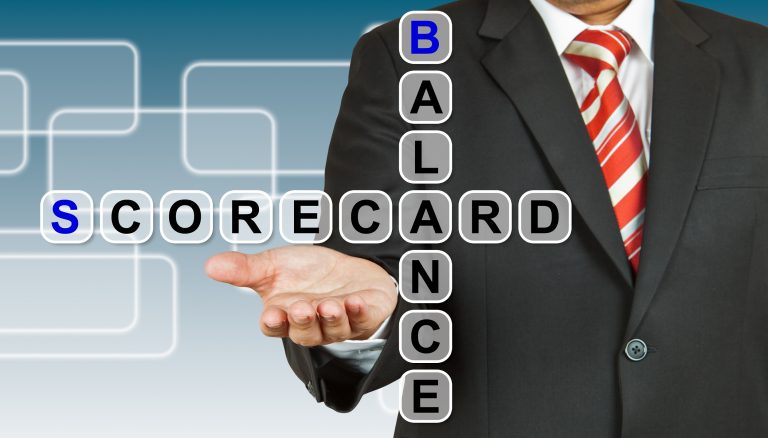
STEPS OF CREATING SFO
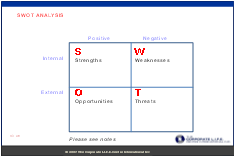
CLCI consultants work closely with the Senior Leadership Team of the client organization to help it decide its strategic direction and create its strategic plan. This is the most important and critical phase of strategic planning as it must deliver unique value to the organization’s customers and distinguish the organization from its competitors.
Strategies are developed by the senior leaders of an organization, and implemented by the entire management and operational staff. CLCI works with the senior leadership team to clarify the mission, values and vision statements and to conduct strategic analysis leading to strategy formulation. The decisions made in the strategy planning sessions are captured on a template called the Strategic Framework, which becomes the precursor for the Strategy Map.


CLCI facilitation process helps the organization create a heightened awareness of the importance of constantly scanning the internal and external environment, creative thinking, focusing on the common vision, delighting the customers, and upholding values at all times. It also encourages open and candid communications, transparency, teamwork, breaking down of interdepartmental silos and risk taking.
STEPS OF DESIGNING THE STRATEGY
To lead the senior leaders and others in the organization to consider alternate ways of thinking and doing business, the CEO/ President must first get their attention.
The CLCI Model suggests that the CEO/ President first talk about the urgent and important issues that affect the organization, and the consequences delaying the response or not responding at all. Making a Case for Change is about building awareness for the urgent need to take stock of the dire situation the organization finds itself in.

A: The Burning Platform
High level issues that management foresees as likely, such as:
-
Anticipated future customer demand changes
-
Potential competitor responses
-
Technological innovations by competitors
-
Need to arrest current dismal performance
B. Big, Hairy Audacious Goals (BHAGs) set by the executive leadership
-
Ambitious goals set by the Board / top management to accomplish what would be otherwise considered impossible.
-
Such goal often times to transform the nature of the business.
C: Management Directives
-
Instructions of the top management you can’t ignore, and must abide at all times.
-
The reasons behind these instructions may or may not be explained by the top management.
This helps understand the extent to which the strategy and structure of the organization are matched or mismatched to the developments in the environment:
A: Strategic Performance Assessment (QuadStrat)
QuadStrat is a suite of organization assessments to pin point the best opportunities for strategic performance improvement. These assessments clearly illustrate management and employee alignment and answer the question: Are the senior managers on the same page and to what degree are your employees engaged and committed?
The assessment covers 35 key business disciplines tied to 3 critical areas of the organization: strategy, design, and culture. The report compares results with the over 3,000 organizations global best practice database and includes a “Strategic Performance Index” which provides the overall performance score in relation to this database.
Developed with the support of UCLA and Pepperdine University, QuadStrat assessments are rooted in fact-based primary and secondary research, yet are designed with practical business application in mind.
B: Internal Scan:
CLCI facilitates a session of the Senior Leadership Team to take stock of the Strengths, Weaknesses, Opportunities and Threats affecting the organization.
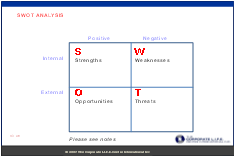
C: External Scan
CLCI facilitates a serious of sessions of the Senior Leadership Team to help it:
-
Understand changes going on in the environment that may affect the fortunes of the organization
-
Analyze the competitive position
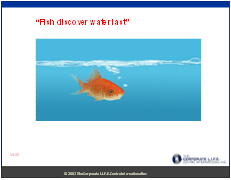
The sessions the SLT participates in relate to the following analyses:
- PESTEL Analysis
- Porter’s Five Forces Analysis
- Competitor Analysis
- Growth Strategies (Product/ Market Matrix)
- Boston Consulting Group Index
- Market Segmentation and targeted customer identification
- Identifying customers to be retained/ dropped/ attracted
- Selecting from Value Propositions and Competitive Differentiators
- Other analyses
This is about formulating possible courses of action, evaluating them, and then making a choice between them.
Key aspects for consideration
- Customers
- Products/ Services
- Value Proposition
- Processes
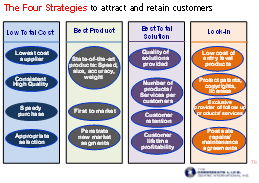
Some of the other points for consideration while making strategic choices are:
- Deciding the basis on which the organization will compete or sustain excellence
- Choosing alternate directions in which to develop, as well as the methods
- Making choice about customers, products and value proposition
- Making choice of competitive differentiators and processes
- Using Financial models to test that choices made will support strategy
A. FINANCIAL ANALYSES TO SUPPORT STRATEGY
The financial model must incorporate key strategic assumptions. These key performance indicators may be excellent choices for measures, such as:
- Key financial ratios that must be met for your bankers
- Customer or volume growth rates necessary to achieve returns on capital investment
- Manpower productivity levels that must be managed to contain unit costs
- “Break-through” in technologies that are expected to meet competitive challenges.
The model can be simple and high-level, or complex and integrated with the organization’s permanent business / management processes. It is important that the model use the same definitions for terms / measures as the accounting system. This will enable accountability for results. Scenarios are then run based on targets for all measures to ensure consistency between inter-related variables and that the plan will meet high-level shareholder / financial goals.
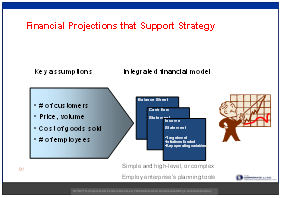
B: FINANCIAL RATIOS
The following five categories of financial analysis ratios are the most commonly used:
- Liquidity Ratios
- Leverage-Capital-Structure Ratios
- Profitability Ratios
- Turnover Ratios
- Capital-Market Ratios
The Strategic Framework lays the foundation of designing the Strategy Map and is an important template that brings together the vital elements of strategic thinking, listed below:
- Vision
- Mission
- Values
- Critical Success Factors
- Corporate Goals
- Themes
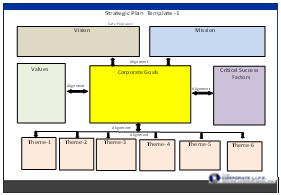
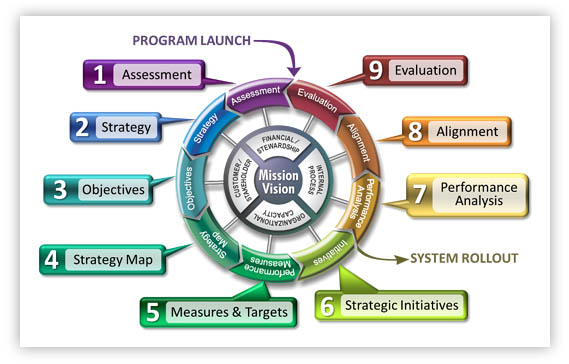
Stage 2 – Translate your strategies into Balanced Score Cards (BSC)
Translating the Strategy into Balanced Scorecards is the second stage in Creating a Strategy-Focused Organization
After guiding the Senior Leadership Team through cycles of analysis, research, and animated discussions punctuated by periods of quiet reflection during the first stage of “Designing the Strategy”; designing the Strategy Maps and the Balanced Scorecard becomes an interesting next challenge for the Senior Leaders.
Strategy Map
A Strategy Map provides a visual representation that tells the story of the organization and describes the logic of the strategy. It is the missing link between strategy formulation and strategy execution.
On the Strategy Map, the Corporate Goals and Objectives are distributed into the following four Perspectives:
The Financial Perspective examines if the company’s strategy will contribute to the bottom-line improvement of the company. The Financial Perspective represents the long-term strategic objectives of the organization and thus it incorporates the tangible outcomes of the strategy in traditional financial terms. The Financial performance is a lag indicator and provides the ultimate definition of an organization’s success and describes how to create growth in the shareholder value. Depending on strategy, leaders of the organization follow a combination of growth strategy (i.e., to increase revenues) combined with varying emphasis on productivity strategy (i.e., to cut costs through efficiency). Some of the most common financial measures that are incorporated in the financial perspective are EVA, revenue growth, costs, profit margins, cash flow, net operating income, etc.
A generic slide showing the Financial Perspective
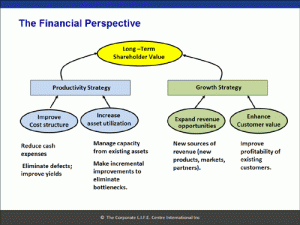
The Customer Perspective defines the value proposition that the organization will use in order to satisfy customers and generate more sales to the targeted customers segments. The Leading Measures that are selected for the customer perspective should measure both the value that is delivered to the customer (value position) which may involve time, quality, performance and service and cost and the outcomes that come as a result of this value proposition (e.g., customer satisfaction, market share). The value proposition can be centered on one of the three: operational excellence, customer intimacy or product leadership, while maintaining threshold levels at the other two.
A generic slide showing the Customer Perspective
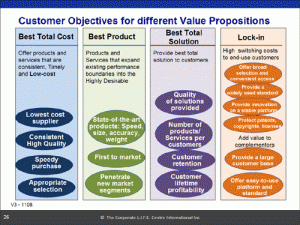
The Internal Process Perspective focuses on all the activities and key processes required in order for the company to excel at providing the value expected by the customers. Internal Processes are lead indicators where management intervention is possible to affect customer and financial outcomes.
Internal processes can be grouped into:
- Operations Management – improving asset utilization, supply chain management, etc
- Customer Management – expanding and deepening relations, innovation (by new products and services
- Regulatory & Social – establishing good relations with the external stakeholders.
A generic slide showing Internal Processes Perspective
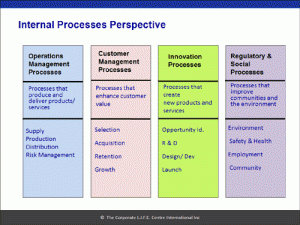
The Learning & Growth Perspective focuses on the intangible assets of an organization, mainly on the internal skills and capabilities of the employees that are required to support the value-creating internal processes. The Learning & Growth Perspective focuses on:
- Human Capital-Jobs and people issues
- Information Capital- Systems and technology issues
- Organization capital- Organizational climate and quality of work-life
The Learning and Growth objectives describe how the people, technology, and organizational climate combine to support strategy. Measures in this perspective are lead indicators for improvements in the internal processes, customer and financial perspectives.
A generic model of the Learning & Growth Perspective
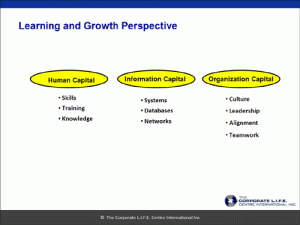
The Strategy Map also shows the cause-and-effect linkages between Vision, Corporate Goals and various Objectives that are distributed into various Themes.
CLCI uses special software to create Strategy Map in full color. The Strategy Map is displayed with pride in boardrooms, offices, as well as distributed to the staff, suppliers and vendors.
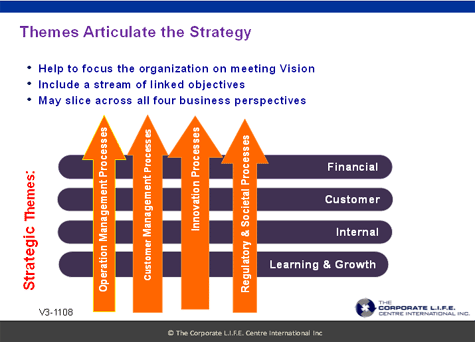
The Balanced Scorecard
The Balanced Scorecard is a Performance Measurement tool to assess progress toward the Corporate Goals.
CLCI helps create the Corporate Balanced Scorecard to provide the vital link between Vision, Mission, Values, Corporate Goals and Critical Success Factors on the one hand, and the Operational Objectives, Measures, Targets, Initiatives and Action Items on the other. Also identified on the Balanced Scorecard are the Sponsors and Owners of Corporate Goals, Objectives and Initiatives.
The Balanced Scorecard helps in communicating, motivating, empowering employees, funding Initiatives and rewarding progress made toward Corporate Goals. A Balanced Scorecard is also used in a variety of other ways:
- Clarifying strategy and making strategy operational
- Driving strategy execution
- Identifying and aligning strategic initiatives
- Linking budget with strategy
- Aligning the organization with strategy
- Conducting periodic strategic performance reviews
CLCI works with the Senior Leadership Team of the Client to first create its Corporate Balanced Scorecard, and later the Departmental Scorecards.
Specially designed software is used to maintain data such as:
- Corporate goals
- Objectives
- Measures
- Targets
- Initiatives
- Name of Goal owner
- Name of Objective owner
- Name of Initiative Owner
- Other details
CLCI helps clients define the leading and lagging measures for the objectives on the Balanced Scorecard.
CLCI uses specially designed software to load the Balanced Scorecard data for easy tracking and monitoring of progress made in implementing the Corporate Goals, Objectives and Initiatives.
CLCI also trains selected staff members from the organization to work as BSC Coordinators for their departments.
In the process of working together to research / explore, analyze, debate, understand, discover, measure and decide what employees must do together to realize the Vision, inter departmental silos automatically break down, and a new culture of being a Strategy-Focused Organization.
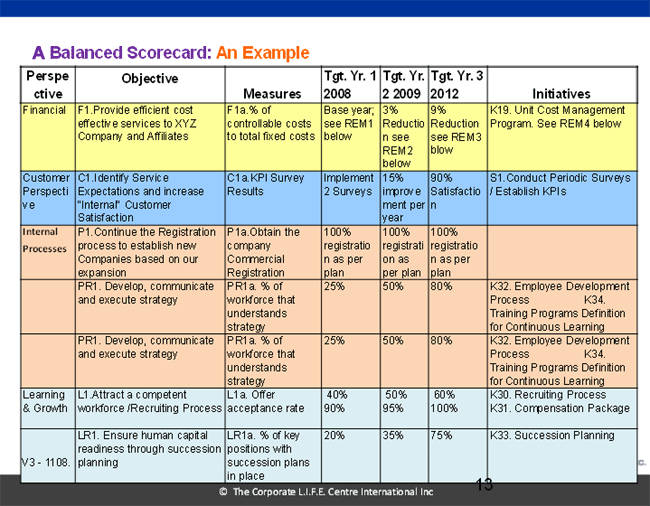
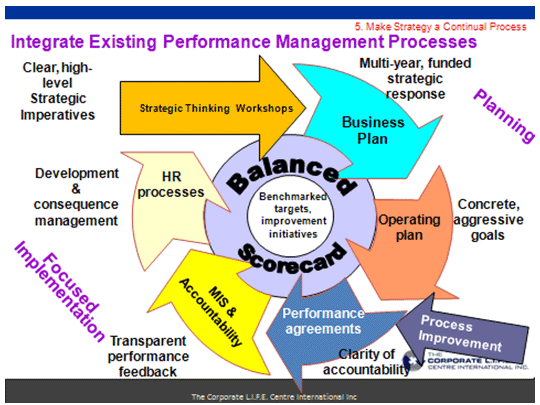
Stage 3 – Implementing the Strategy
Implementing the Strategy is the third stage in Creating a Strategy-Focused Organization
Implementing strategy is as critical as designing it. The Senior Leadership Teams of most organizations do a great job of Designing the Strategies and Translating the Strategy into Balanced Scorecard, but they are less enthusiastic when it comes to Implementing the Strategy.
In failing to move the strategy from the boardroom to the backroom and to the frontlines of daily operations, these organizations fail to reap the full harvest of their efforts because of shoddy / half-hearted implementation.
In their latest book “The Execution Premium” Robert Kaplan and David Nortor highlight that companies using a formal system for implementing strategy consistently outperform their peers who fail to operationalize their strategy. Companies need to develop a comprehensive management system to ensure an explicit link between the strategies and daily operations. They also need to address two key questions: Which business process improvements are most critical for executing the strategy and How to link strategy with operating plans and budgets.
CLCI provides a comprehensive and integrated management system to help clients overcome difficulties and frustrations that many Senior Leadership Teams experience when attempting to implement the strategy.
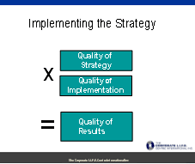

CLCI consultants coach and facilitate the Senior Leadership Teams through the three critical steps of strategy implementation outlined below:
After helping create the Vision Statement, the Corporate Strategy Map and the Corporate Balanced Scorecard, CLCI helps cascade the Corporate Goals to the various Business Units and Departments. This linkage of Business Units and Departmental strategies to the Corporate Strategy, and the linkage of Corporate Strategy to the Vision Statement create alignment and synergy across the organization.
This slide shows alignment between Corporate, Business Line, Departmental and team/individual objectives
Each item on the Strategy Map / Scorecard is supported by additional detail
-
Easily communicate as a stand-alone document
-
Serve as historic supporting documentation to clarify understanding of objectives for new core team or management that may come in later.
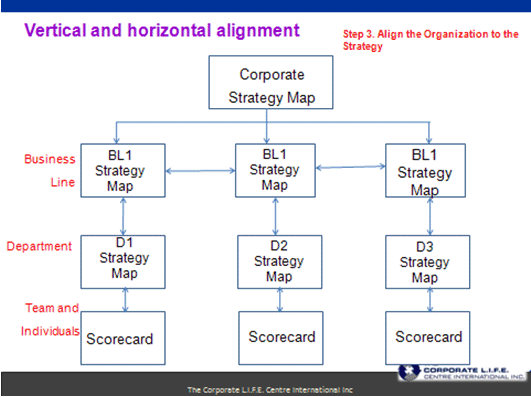
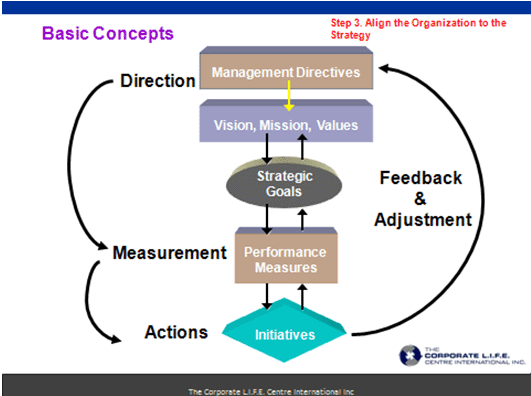
Align the Organization to the Strategy
This is about linking every employee to the Division’s /Department’s or the Corporate strategy. This is also about making everyone in the organization understand strategy and be motivated to help the organization achieve its objectives.
CLCI helps the all Divisions /Departments within the organization to link their strategies with the corporate strategy designed by the Senior Leadership Team. This linkage creates alignment and synergy across the organization.
CLCI Leads the Senior Leadership Team in making Strategy part of the everyday job of the operational and other staff throughout the organization, by taking the following actions:
A: CREATING STRATEGIC AWARENESS THROUGH CONTINUOUS COMMUNICATION
- Develop buy-in to support the organization’s vision / strategic direction, mission
- Introduce the concept of BSC as a strategic performance management system to:
- Understand strategy
- Understand individuals’ contribution documented in Performance Management Process
- Single planning platform at the center of governance process
- Measure results with accountability/commitment
- Explain how employees will benefit
- Encourage employees to adopt the concept
B: CONDUCTING INFORMATION CAMPAIGN
- Develop buy-in to support the organization’s vision, mission, strategic goals
- Develop an understanding of strategy
- Get commitment to execute
- Reinforce:
- What will change (understand strategy, measure results)
- What will stay the same (accountability through Operating Plan)
- Give direction as to what to do next
- Governance process
- Assigning responsibility for initiatives
- Integration into Performance Management/ Appraisal Processes
C: PROVIDING ON-GOING FEEDBACK
- BSC, Operating Plan and Business Plan should use the same bases
- BSC should not create a new reporting or communication infrastructure or bureaucracy
- Communicate as part of existing planning processes (Op Plan, Business Plan)
- Use as the format for initial communication and discussion of “new” strategy
- On-going accountability, cheer leading and performance feedback
Typical compensation schemes involve multiple tiers of performance
- Corporate incentives align employees and business units to Corporate Goals
- Business Unit/ Departmental incentives reward all employees when they achieve their Business Unit/Departments Balanced Scorecard targets
- Local incentives reward individuals when they achieve their personal targets.
This is about continually reviewing and researching internal and external conditions periodically / once a year to learn of new opportunities, threats and competitive conditions that may need a strategic course shift.
This step includes linking every employee to the business unit and the corporate strategy and making everyone in the organization understand strategy and be motivated to help the organization achieve its objectives.

Making Strategy a Continual Process
To help the client put into practice the final step of building a Strategy Focused Organization: “Making Strategy a Continual Process,” CLCI helps the Senior Leadership Team to develop and implement a governance process. Governance includes:
A: Resource Management
- Budget is driven by strategy
- Planning is linked to strategy
- Portfolio of strategic initiatives is aligned to themes
B: Key Process Management
- Process improvement is aligned to strategy
- Best practice sharing is in place
C: Learning & Control
- Review and adapt strategy
- Data and analytics guide strategy
CLCI always encourages the Senior Leadership Team to prepare well for the meetings
Quarterly BSC Governance Meeting:
- Ensure that all data gathering and reporting is complete before the meeting.
- Discuss the progress of key action items in the meeting
- Re-prioritize as required; stop/re-position failing actions
- Identify and form new initiatives where needed to achieve objectives
- Ensure proper resourcing; break-down silos and work as a team
Annual Strategy Review:
- Completely review of the entire Strategic Framework: Vision, Mission, Values, Corporate Goals, and Critical Success Factors, and make adjustments as necessary
- Re-visit Objectives, Measures, Initiatives etc for alignment with Corporate Goals and Vision, and make adjustments as necessary
- Review roles and accountabilities, and make adjustments as necessary
CLCI ALWAYS PROMPTS THE SLT TO AVOID THE FOLLOWING BEHAVIORS AT MEETINGS
- Show up to the meeting unprepar
- Review the Objectives/Initiatives and Measures for the first time in the meeting
- Discuss each measure in detail in the meeting – one after another
- Discuss performance out of context (i.e., without considering the Objectives and causal relationships)
- Get mired in unnecessary detail – “Analysis Paralysis”
- Re-hash old issues over and over
EXECUTIVE BEHAVIOR IN A STRATEGY FOCUSED ORGANIZATION
- Management communicates strategic performance expectations -- does not control behavior
- Management has fact based discussions about strategy, learning how to interpret and act based on imperfect information
- Feedback and learning are critical to ‘making strategy a continuous process’
- Management has a key role in enabling the performance of the workforce
WHEN STRATEGY WORKS WELL
- The Senior Leadership Team leaves functional / silo bias at the door
- The discussion is about strategic issues, not necessarily particular measures
- The conversations are constructive, not focused on blame. Management’s job is to enable performance
- There is a strong willingness to take ownership to resolve and address issues impacting performance
- There is preparation and follow-through
- The meetings are structured and well-managed
WHEN STRATEGY DOESN’T WORK WELL
- Same old behaviors – not willing to change
- Too much focus on the measures, not enough thoughtful analysis of issues and implications
- Not properly resourced
- Used as a political tool – who to blame for poor performance
- Wait until 100% perfect, not iterative and improvement focused
- Put aside when ‘things get busy’
Fixed Events
MONTHLY MIS REPORT
- Care has to be taken not to create duplicate reporting
- Base on Business Line/ Departmental performance on KPI targets, organized by Strategic Objective
QUARTERLY BSC GOVERNANCE MEETING
- Ensure that all reporting and data gathering is complete (KPI Owners, before meeting)
- Discuss the progress of key action items
- Reprioritize as required; stop/reposition failing actions
- Identify and form new initiatives where needed to achieve objectives
- Ensure proper resourcing; break-down silos and work as a team
QUARTERLY BSC GOVERNANCE MEETING
- Revisit mission, vision, objectives, KPIs; review for alignment with strategy
- Complete review of the entire framework; make revisions and adjustments as necessary
- “Take a step back” and review roles and accountabilities
BSC COORDINATOR
CLCI encourages the Senior Leadership Team to consider creating a Corporate Strategy Office with a enthusiastic member acting as Corporate Strategy Officer, who besides her/his other duties, does the following:
- Ensures all performance data is gathered and assembled
- Finalizes Targets
- Manages the Measures in detail
- Prepares Monthly Reports
- Liaises with contributors to Measures data
- Documents meeting outcomes
- Maintains rolling issues and actions list
- Ensures education is available when questions arise







